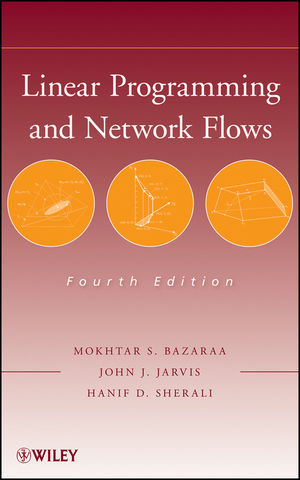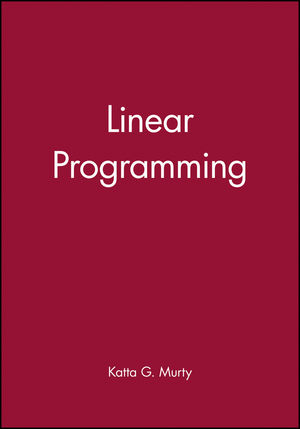Linear Programming And Network Flows Solution Manual Free Download
Download Product Flyer
Download Product Flyer
Download Product Flyer is to download PDF in new tab. This is a dummy description. Download Product Flyer is to download PDF in new tab. This is a dummy description. Download Production Flyer is to download PDF in new tab. This is a dummy description. Download Product Flyer is to download PDF in new tab. This is a dummy description.
Description
The authoritative guide to modeling and solving circuitous issues with linear programming—extensively revised, expanded, and updated
The but book to treat both linear programming techniques and network flows under one cover, Linear Programming and Network Flows, Fourth Edition has been completely updated with the latest developments on the topic. This new edition continues to successfully emphasize modeling concepts, the pattern and assay of algorithms, and implementation strategies for problems in a multifariousness of fields, including industrial engineering, direction science, operations research, computer scientific discipline, and mathematics.
The book begins with basic results on linear algebra and convex analysis, and a geometrically motivated study of the structure of polyhedral sets is provided. Subsequent capacity include coverage of cycling in the simplex method, interior bespeak methods, and sensitivity and parametric analysis. Newly added topics in the 4th Edition include:
-
The cycling phenomenon in linear programming and the geometry of cycling
-
Duality relationships with cycling
-
Elaboration on stable factorizations and implementation strategies
-
Stabilized column generation and acceleration of Benders and Dantzig-Wolfe decomposition methods
-
Line search and dual ascent ideas for the out-of-kilter algorithm
-
Heap implementation comments, negative cost circuit insights, and boosted convergence analyses for shortest path issues
The authors present concepts and techniques that are illustrated past numerical examples along with insights complete with detailed mathematical analysis and justification. An emphasis is placed on providing geometric viewpoints and economic interpretations besides as strengthening the understanding of the fundamental ideas. Each chapter is accompanied by Notes and References sections that provide historical developments in addition to current and future trends. Updated exercises permit readers to test their comprehension of the presented material, and all-encompassing references provide resources for farther study.
Linear Programming and Network Flows, Fourth Edition is an excellent book for linear programming and network menses courses at the upper-undergraduate and graduate levels. It is too a valuable resource for practical scientists who would similar to refresh their understanding of linear programming and network menses techniques.
Cannot be combined with any other offers.
Original Price:$309.xc
Purchased together:$232.42
salvage $77.48
Added to Your Shopping Cart


Buy Both and Save 25%!
This detail:Linear Programming and Network Flows, 4th Edition
Linear Programming(Paperback $214.95)
Cannot be combined with any other offers.
Original Price:$369.90
Purchased together:$277.42
salvage $92.48
Added to Your Shopping Cart
Cannot be combined with any other offers.
Original Price:$286.95
Purchased together:$215.21
save $71.74
Added to Your Shopping Cart
Table of contents
Preface.
I: INTRODUCTION.
1.1 The Linear Programming Problem.
one.2 Linear Programming Modeling and Examples.
1.3 Geometric Solution.
1.4 The Requirement Space.
1.5 Notation.
Exercises.
Notes and References.
TWO: LINEAR ALGEBRA, CONVEX ANALYSIS, AND POLYHEDRAL SETS.
ii.one Vectors.
two.2 Matrices.
2.3 Simultaneous Linear Equations.
ii.iv Convex Sets and Convex Functions.
2.5 Polyhedral Sets and Polyhedral Cones.
2.6 Extreme Points, Faces, Directions, and Farthermost Directions of Polyhedral Sets: Geometric Insights.
2.seven Representation of Polyhedral Sets.
Exercises.
Notes and References.
3: THE SIMPLEX METHOD.
three.ane Extreme Points and Optimality.
3.ii Bones Viable Solutions.
three.3 Key to the Simplex Method.
iii.4 Geometric Motivation of the Simplex Method.
3.5 Algebra of the Simplex Method.
three.6 Termination: Optimality and Unboundedness.
3.vii The Simplex Method.
iii.8 The Simplex Method in Tableau Format.
3.9 Block Pivoting.
Exercises.
Notes and References.
Four: STARTING SOLUTION AND CONVERGENCE.
4.1 The Initial Basic Feasible Solution.
4.2 The Two-Stage Method.
4.3 The Big-Thou Method.
4.4 How Large Should Big-M Be?
iv.5 The Single Artificial Variable Technique.
4.6 Degeneracy, Cycling, and Stalling.
4.7 Validation of Cycling Prevention Rules.
Exercises.
Notes and References.
5: SPECIAL SIMPLEX IMPLEMENTATIONS AND OPTIMALITY CONDITIONS.
five.1 The Revised Simplex Method.
5.2 The Simplex Method for Bounded Variables.
5.3 Farkas' Lemma via the Simplex Method.
v.4 The Karush-Kuhn-Tucker Optimality Conditions.
Exercises.
Notes and References.
6: DUALITY AND SENSITIVITY Assay.
6.1 Formulation of the Dual Trouble.
six.2 Primal-Dual Relationships.
six.3 Economic Interpretation of the Dual.
6.4 The Dual Simplex Method.
6.5 The Primal-Dual Method.
six.vi Finding an Initial Dual Feasible Solution: The Artificial Constraint Technique.
6.7 Sensitivity Assay.
6.eight Parametric Analysis.
Exercises.
Notes and References.
SEVEN: THE DECOMPOSITION PRINCIPLE.
7.1 The Decomposition Algorithm.
vii.2 Numerical Example.
vii.3 Getting Started.
7.4 The Example of Unbounded Region Ten.
seven.5 Cake Diagonal or Angular Structure.
seven.6 Duality and Relationships with other Decomposition Procedures.
Exercises.
Notes and References.
Eight: COMPLEXITY OF THE SIMPLEX ALGORITHM AND POLYNOMIAL-Time ALGORITHMS.
eight.1 Polynomial Complexity Issues.
8.2 Computational Complexity of the Simplex Algorithm.
8.3 Khachian's Ellipsoid Algorithm.
8.4 Karmarkar's Projective Algorithm.
8.five Analysis of Karmarkar'south Algorithm: Convergence, Complexity, Sliding Objective Method, and Bones Optimal Solutions.
eight.6 Affine Scaling, Key-Dual Path-Post-obit, and Predictor-Corrector Variants of Interior Point Methods.
Exercises.
Notes and References.
NINE: MINIMAL-COST NETWORK FLOWS.
nine.one The Minimal-Toll Network Period Problem.
9.two Some Bones Definitions and Terminology from Graph Theory.
nine.3 Properties of the A Matrix.
9.iv Representation of a Nonbasic Vector in Terms of the Bones Vectors.
ix.v The Simplex Method for Network Flow Problems.
ix.six An Instance of the Network Simplex Method.
9.7 Finding an Initial Basic Feasible Solution.
9.8 Network Flows with Lower and Upper Bounds.
ix.9 The Simplex Tableau Associated with a Network Period Trouble.
ix.10 List Structures for Implementing the Network Simplex Algorithm.
nine.11 Degeneracy, Cycling, and Stalling.
ix.12 Generalized Network Problems.
Exercises.
Notes and References.
X: THE TRANSPORTATION AND Assignment Bug.
10.1 Definition of the Transportation Problem.
10.2 Properties of the A Matrix.
ten.3 Representation of a Nonbasic Vector in Terms of the Basic Vectors.
10.four The Simplex Method for Transportation Bug.
ten.v Illustrative Examples and a Notation on Degeneracy.
10.6 The Simplex Tableau Associated with a Transportation Tableau.
10.seven The Assignment Problem: (Kuhn's) Hungarian Algorithm.
10.8 Alternating Path Footing Algorithm for Assignment Problems.
10.ix A Polynomial-Fourth dimension Successive Shortest Path Approach for Assignment Problems.
10.10 The Transshipment Problem.
Exercises.
Notes and References.
ELEVEN: THE OUT-OF-KILTER ALGORITHM.
11.1 The Out-of-Kilter Formulation of a Minimal Cost Network Flow Trouble.
11.2 Strategy of the Out-of-Kilter Algorithm.
11.3 Summary of the Out-of-Kilter Algorithm.
11.4 An Example of the Out-of-Kilter Algorithm.
11.5 A Labeling Procedure for the Out-of-Kilter Algorithm.
11.six Insight into Changes in Primal and Dual Role Values.
11.vii Relaxation Algorithms.
Exercises.
Notes and References.
TWELVE: MAXIMAL Period, SHORTEST PATH, MULTICOMMODITY Menstruation, AND NETWORK SYNTHESIS PROBLEMS.
12.one The Maximal Period Problem.
12.ii The Shortest Path Problem.
12.3 Polynomial-Time Shortest Path Algorithms for Networks Having Arbitrary Costs.
12.4 Multicommodity Flows.
12.five Characterization of a Basis for the Multicommodity Minimal-Price Period Problem.
12.6 Synthesis of Multiterminal Flow Networks.
Exercises.
Notes and References.
BIBLIOGRAPHY.
INDEX.
New To This Edition
- Provides a new section on LU decomposition for stable computations likewise as more efficient dual updates schemes using LU factors
- Presents new discussions on the geometry of cycling and provides insights into the nature and construction of examples that admit cycling
-
Elaboration on stable factorizations and implementation strategies
-
Stabilized column generation and acceleration of Benders and Dantzig-Wolfe decomposition methods
-
Additional data or polynomial time algorithms for linear programs
-
Line search and dual ascent ideas for the out-of-kilter algorithm
-
Heap implementation comments, negative cost circuit insights, and additional convergence analyses for shortest path issues
-
The exercises in several chapters have been revised and expanded
-
The Notes and References sections for all the chapters have been updated, along with the bibliography
Reviews
"The book tin can be used both equally reference and as textbook for advanced undergraduate students and first-year graduate students in the fields of industrial engineering, direction, operation research, computer science, mathematics and other engineering disciplines that deal with the subjects of linear programming and network flows." (Zentralblatt MATH, 2011)
Downloads
Features
-
Describes the bones theoretical results and algorithms in nonlinear optimization
- Incorporates timely footnotes and references throughout the text to keep the reader well-informed of changes in the marketplace
-
Provides ample exercises that reinforce the theory and concepts presented in the text, some of which have been enhanced with numerical illustration
DOWNLOAD HERE
Posted by: wildshintaing.blogspot.com